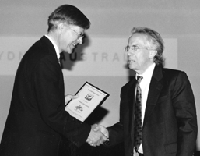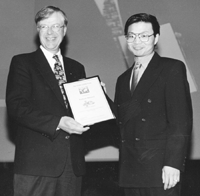ICIAM Prizes Awarded in Sydney
December 1, 2003

Stanley Osher (right), Pioneer Prize recipient, with Olavi Nevanlinna.
Every four years, the International Congress on Industrial and Applied Mathematics draws sizable contingents of mathematical and computational scientists from all corners of the world to learn about one another's successes, current endeavors, and new ideas. Since 1999, an ICIAM highlight has been the awarding of four prizes by some of the sponsoring societies. For three of the prizes---the Lagrange Prize (sponsored by SMAI, SEMA, and SIMAI), the Maxwell Prize (sponsored by the British IMA and the James Maxwell Clerk Foundation), and the Pioneer Prize (sponsored by SIAM)---the selection criteria are as unrestricting as possible: excellence and originality in applied mathematics. The fourth, the Collatz Prize (sponsored by GAMM), also recognizes outstanding work across the spectrum of applied mathematics but is to be given to an outstanding researcher under the age of 42.
Olavi Nevanlinna, president of ICIAM (the Council that masterminds the Congress) and, as such, chair of the ICIAM Prize Committee, awarded the prizes in Sydney, at ICIAM 03, to Enrico Magenes of the University of Pavia (Lagrange), Weinan E of Princeton University (Collatz), Stanley Osher of the University of California, Los Angeles (Pioneer), and Martin Kruskal of Rutgers University (Maxwell).
Collatz Prize
Weinan E, a member of the mathematics department and the Program in Applied and Computational Mathematics at Princeton University, is "a scientist of exceptional vision and scope," according to the Collatz Prize committee. "His work is a sophisticated combination of modeling, mathematical analysis, and numerics, and it is always devoted to providing new insights into real-world processes."

Olavi Nevanlinna (left) presented the Collatz Prize to Weinan E.
Participants in recent SIAM conferences on materials science will not be surprised to find liquid crystals and polymers, epitaxial growth, superconductivity, and micromagnetics on the list of processes investigated by E. A member of the organizing committee for the 2003 conference, E is co-chair of the committee now putting the final touches on the program for the 2004 conference (Los Angeles, May 23-26).
After early contributions in the area of homogenization of fully nonlinear wave equations, the prize committee wrote, E developed a geometrically nonlinear continuum model for liquid crystals that provided a first explanation of the formation of filaments in the smectic-isotropic transition. In micromagnetics, he and colleagues devised new algorithms for the solution of the Landau-Lifshitz-Gilbert equation, making possible reliable and efficient simulation of fast-switching processes and the hysteresis effect in ferromagnetic materials.
Among E's recent results are new techniques for studying the occurrence of rare events in systems with complicated energy landscapes. By introducing stochastic perturbations, he has been able to calculate rates of transition between stable configurations. These ideas became the basis for his explanations of movements of phase boundaries in shape-memory alloys and switching phenomena in thin magnetic films.
E has also turned his attention to fluid dynamics---incompressible flows, turbulence---and statistical physics. Finally, his enduring interest in multiscale problems has also benefited SIAM, with his appointment to the editorial board of Multiscale Modeling and Simulation, SIAM's newest journal.
Pioneer Prize
Purposely not linked to the name of a particular mathematician, the SIAM-funded ICIAM prize recognizes the introduction of applied mathematical methods and scientific computing techniques to an industrial problem area or a new scientific application area. The Pioneer Prize "commemorates the spirit and impact of the American pioneers."
Living up to that colorful image is the 2003 Pioneer Prize recipient, Stanley Osher of UCLA. The prize committee commended Osher for his work on shock-capturing schemes for conservation laws, which have "been extremely influential in computational fluid dynamics," along with the monotone and total-variation-decreasing schemes that he and collaborators developed in the 70s and 80s. His essentially non-oscillatory schemes, introduced later, have been widely applied in compressible CFD. Osher also introduced shock-capturing methods for the solution of Hamilton-Jacobi equations.
With their TV-based work on image restoration, the committee pointed out, Osher, with Leonard Rudin, was among the first to apply PDE methods to image processing. That nonlinear PDEs have become a central approach in image processing could be seen in the program for the first conference of the SIAM Activity Group on Imaging Science (March 2002), where Osher gave an invited talk on dynamic visibility and level set methods (and wrote a short note on the subject for SIAM News (see May 2002). Osher and Rudin put these methods to work in a commercial setting when they founded Cognitech, in 1988.
The prize committee described Osher's work on level set methods as "a fresh, very powerful approach to the numerical solution of free boundary problems." After early work with James Sethian, Osher has worked with various collaborators to address a wide variety of related problems, developing techniques for handling nonlocal velocity laws, triple junctions, and higher codimension sets. He has "demonstrated the value of these techniques," the committee concluded, "by applying them to problems in materials science, geometry, and fluid dynamics."
Lagrange Prize
Cited "for his contributions to the development of applied mathematics at the worldwide level," Enrico Magenes of the University of Pavia received the ICIAM Lagrange Prize for 2003. The prize committee pointed to the "remarkable series of papers" of Magenes and Jacques-Louis Lions that "set the foundations for the modern treatment of partial differential equations," especially those used in applications. The resulting book, Nonhomogeneous Boundary Value Problems and Applications, "has been the reference book for more than thirty years," not only for the completeness of the results included, but also for the authors' strategies for approaching the problems.
Founder (in the early 1970s) and long-time director of the influential Institute for Numerical Analysis in Pavia, Magenes made lasting contributions to a completely new technique for treating free boundary problems by means of variational inequalities; among the "remarkable applications" were fluid flow in porous media and phase-change phenomena. Beyond even his important results, however, the committee found his "major merit" to lie in his commitment and contribution to "a way of doing mathematics that joined the rigour, the elegance and the deepness of so-called pure mathematics with the real-life problems that have to be faced in applications."
Maxwell Prize
Martin Kruskal of Rutgers University received the 2003 ICIAM Maxwell Prize, for achievements that include discovery of "the particle-like behavior of solitary waves, which he named 'solitons,'" and introduction of the inverse scattering transform method for solving the initial value problem for the Korteweg-de Vries equation.
Kruskal showed how solitons could be used to solve initial value problems for a whole class of nonlinear partial differential equations, the prize committee wrote. "A host of further developments by Kruskal and others" resulting from this work has "transformed the theory of nonlinear PDEs."
Also mentioned was Kruskal's "seminal work" in plasma physics and astrophysics. "In particular, he has shown that the singularity of the Schwarzschild solution of Einstein's equations of general relativity is not an actual singularity of the geometry but is an apparent singularity due to the coordinate system." Most recently, the committee concluded, Kruskal has returned to pure mathematics and the study of surreal numbers (the topic he addressed in 1994 at the SIAM annual meeting as that year's John von Neumann lecturer).

